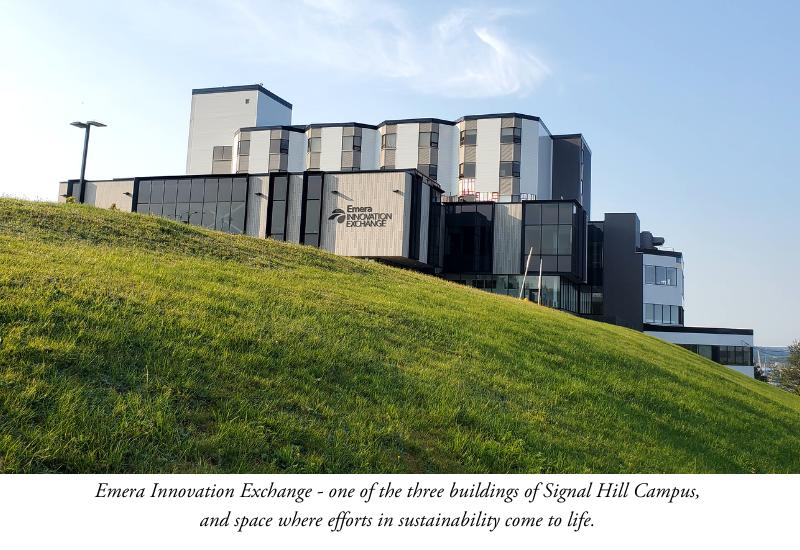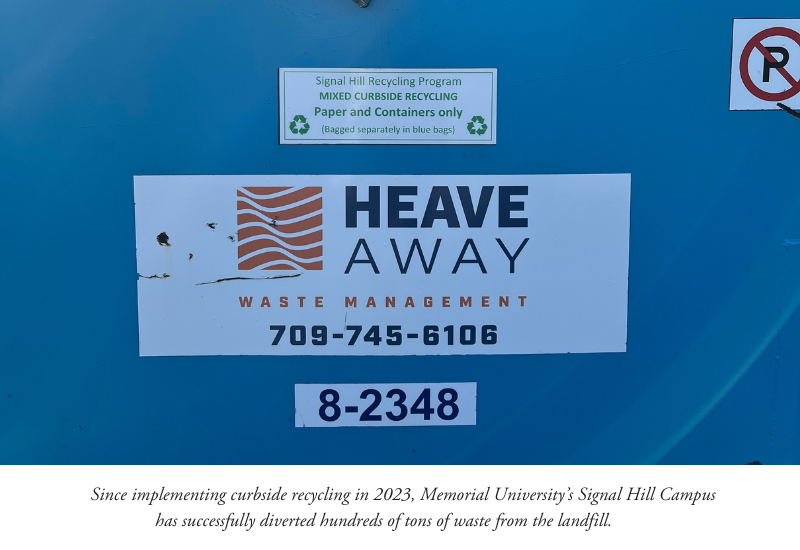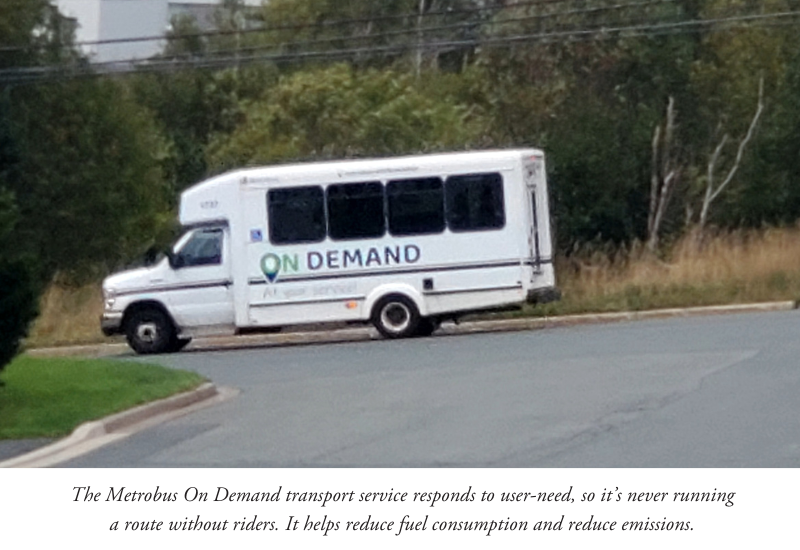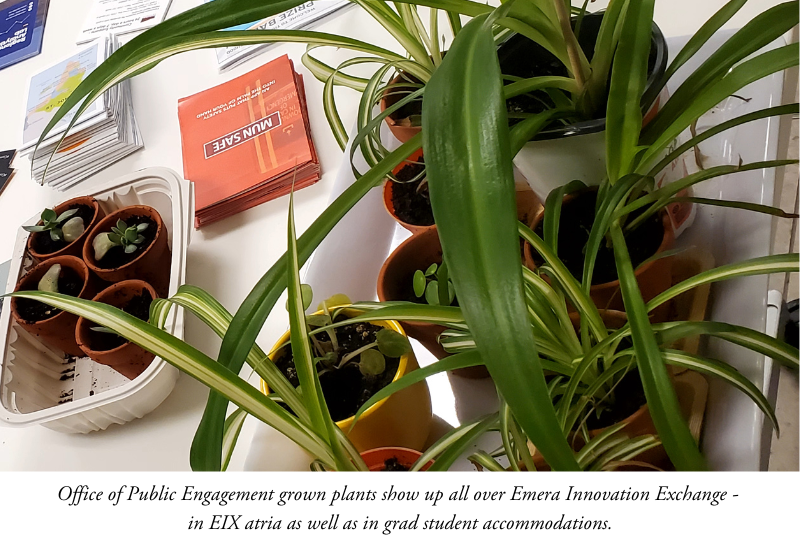Sustainability on Signal Hill Campus - Earth Day 2025

SIGNAL HILL ST. JOHN's is right up there as one of the iconic destinations in Newfoundland and Labrador. About halfway up Signal Hill Road on both sides are the three sisters of Memorial University’s Signal Hill Campus. On the right is Emera Innovation Exchange and Grad Student Accommodations, and a moment later on the left is Johnson Geo Centre.
Immersed in nature, Signal Hill Campus is a feast for the senses. Weather conditions can change from sun to fog to rain to snow in a moment, but wind is usually present. From season to season it can carry the scent of the sea and the caw of gulls whether you’re walking, blueberry picking, apple picking, hiking, or waiting for the bus.
So it’s natural, and in line with Memorial University’s environmental objectives, that Signal Hill Campus would be a leader in sustainable initiatives. Since the Campus first opened it’s been a tumultuous ride toward sustainability, with snowmaggedon and the pandemic recalibrating plans in the earlier years.
Now ten years after the first grad students moved in, Signal Hill Campus is taking a good look at sustainability.
Director Operations/Conference and Event Services Marie-Claude Renaud says, “Issues of sustainability are vital to our operations from all views - environmentally, economically, and socially. We’re getting a handle on where we are on our sustainability journey, and are looking for ways to progress further.”
Here’s a round-up of existing and planned sustainability initiatives - bigger and smaller - that SHC is taking on in the road to sustainability.
Signal Hill Campus Wide Sustainability Initiatives
WASTE MANAGEMENT / There are SHC-wide recycling systems for cardboard, plastics, paper and batteries. Contractor Heave Away reports that since implementing curbside recycling in 2023, Memorial University’s Signal Hill Campus has successfully diverted hundreds of tons of waste from the landfill.

TRANSPORTATION / In 2023 Signal Hill Campus changed the student transportation system to Metrobus On Demand. The On Demand responds to user-need, so helps reduce fuel consumption and reduce emissions. For those who prefer two-wheeled transport, Signal Hill Campus offers the community use of rentable bike lockers in season.

FOOD SERVICE / Red Oak Catering is the exclusive caterer for Signal Hill Campus. Locally-owned and locally-operated, in 2024 Red Oak implemented new policies and procedures toward reducing their carbon footprint and reducing waste. Initiatives include recycling, intentional conservative use of energy resources, and the distribution of unserved food for consumption to reduce food waste and help alleviate community hunger. Red Oak is also introducing more vegetarian choices to their menu for a smaller environmental footprint.
Sustainability by the Buillding on Signal Hill Campus
The three buildings of Signal Hill Campus range in age from 20+ years to 60+ years. Built in the 60s and refurbished in 2015, Signal Hill Campus Accommodations is where more than 80 students from across North America and around the planet get to live. The Emera Innovation Exchange and Conference Center opened in 2018, and is where dozens of Memorial University staff and associates get to work. Built in 2002, and becoming part of Signal Hill Campus in in 2019, Johnson Geo Centre is the province’s science centre where the story of the origin of the earth is told.
They are three very diffenent, very beautiful spaces perched amid rocks and trees, barrens and trails, ponds and North Atlantic coastline. It's an ideal setting for sustainability.
EMERA INNOVATION EXCHANGE (EIX) – designed by architect Jeremy Bryant, and on the footprint of the Battery Hotel, EIX features open space, big windows and gorgeous light. In a 2021 article Architect Bryant said ‘The decision to work with the original buildings was a sustainable choice, and it also speaks to the great tradition of passing down knowledge.’ EIX offices feature motion sensitive lighting that increases energy savings by turning off or turning down the lights when rooms are unoccupied.
GRAD STUDENT ACCOMMODATIONS – Grad Student Accommodations was originally built as a hotel and was refurbished to feature condo-style rooms with shared kitchens on each of the floors. A windows upgrade in the Accommodations Tower was completed in April 2025. Better windows enhance energy efficiency by reducing heat transfer and air leakage.

JOHNSON GEO CENTRE – When it was first built, the Johnson Geo Centre was one of the first buildings in St. John's to use geothermal technology for heating and cooling. In 2016 Geo made the switch from halogen to LED lighting, resulting in increased energy savings. Through its public programming the Johnson Geo Centre regularly features presentations and exhibits that inform and education on sustainability.
The Climate Collective is a project that operates out of the Johnson Geo Centre. This spring, the Climate Collective has started construction of a living wall that will serve as a demonstration of sustainable design in action. On a larger scale, living walls can reduce urban heat, absorb carbon dioxide, and improve air quality.
Grassroots Sustainability Initiatives at Signal Hill Campus Units
Emera Innovation Exchange is home to several University units and all have access to shared printing services. EIX-wide, the default option for printing is double-sided. It’s a small thing, but it adds up. The printer room is also the location for battery-recycling drop-off.
Several Signal Hill Campus units are moving ahead with individual sustainability initiatives.
Gardiner Centre – As the Faculty of Business Administration’s professional development hub, Gardiner Centre integrates sustainable practices into its programming in a variety of meaningful ways. Much of the Centre’s training is full-day or multi-day courses or programs, where lunch and snacks are provided. To reduce waste, snacks are purchased in bulk to minimize packaging, and meals are served using reusable mugs, water glasses, dishes, and cutlery. Gardiner Centre also participates in Memorial University’s campus-wide recycling programs. To limit paper consumption, the Centre prioritizes digital materials and minimizes printing whenever possible. For repeat clients, name tent cards and other materials are thoughtfully reused, reinforcing Gardiner Centre’s commitment to sustainability in everyday operations.
Office of Public Engagement - With its big beautiful south-facing windows, the team at the Office of Public Engagement love sowing and growing plants from succulents to pumpkins. The team enjoys sharing the bounty with Graduate Students that in turn improve air quality and promote well-being in student accommodations. Also, through its competitive funding programs, many projects that are associated with sustainability have received funding support from OPE.

Operations / Conference and Event Services – The Ops/CES team uses sustainable practices in running events such as reducing and reusing materials for signage, décor, and props. In the CES office, the team runs a simple, in-house composting program. Memorial’s SHC Maintenance team reports that the pilot compost project, which began in the summer of 2024, has reduced the volume of waste that goes to the landfill. The team is looking into extending the pilot project to Grad Student Accommodations in the fall of 2025.
In March of 2025 CES partnered with non-profit Newfoundland and Labrador Environment Network to support ‘Green Conversations’ – a series of talks about issues related to environmental action and sustainability which will take place on campus 2025-2026. Ops/CES is also developing a tree planting project in conjunction with the Signal Hill Campus Reunion planned for fall 2025. From a financial sustainability perspective, a portion of revenues from event bookings at Emera Innovation Exchange supports student innovation and entrepreneurship.
Marie-Claude Renaud says, “When we look at the big picture, it’s good to see what is being done for sustainability at Signal Hill Campus. It also shows us how we can progress in the future. Right now, we see areas where we can do more and we look forward to developing systems to support them.”